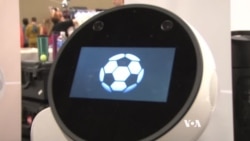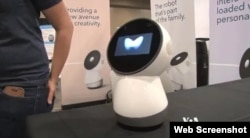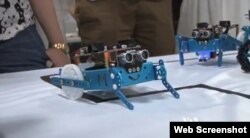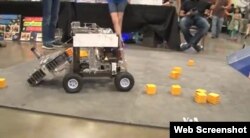R2-D2, C-3PO and Rosie from the Jetsons have interacted with humans, in fiction, as one of our own for decades. Siri talks directly to the user and sometimes it can be mischievous and sarcastic.
If you think a world in which robots interact with humans is in a galaxy far, far away, you are dead wrong.
For years, the robot community has worked to develop artificial intelligence, an integral part of achieving a real interaction between machines and humans.
This year, during the inaugural installment of Robot Ranch, part of the South by Southwest Interactive festival, the robot Jibo left many speechless.
“Unlike your iPad or your tablet, you don’t poke him. You interact with him from a social angle,” Jonathan Ross, head of SDK of Jibo told VOA. “He interacts with you using voice, using gesture, using expression. He can read expressions in your face.”
Jibo is almost 28 centimeters tall and a little more than two kilograms. It looks like an appliance but it couldn’t be farther from it.
Face, expression recognition
The robot recognizes faces and addresses its owners by name.
If it’s raining outside, Jibo will recommend you to take an umbrella. During a birthday party, Jibo tracks action around him and can snap candid pictures and videos when he sees people smiling.
When you’re cooking, Jibo can read the recipe for its owner. The robot is connected to the Internet so it can also order a pizza if ordered to do so. Their creators call it the “world’s first family robot,” a companion of sorts.
Jibo’s team argues technology needs to be humanized.
“Technology is cold and flat right now and bringing personality to it, bringing the way we interact with technology closer to how we interact with each other I think is going to be huge,” said Ross.
But even though Jibo was not the only robot in the room during the inaugural Robot Ranch, he was the most sophisticated one.
The creator of the robot, Cynthia Breazal has studied social robotics at the Massachusetts Institute of Technology for years. But this doesn’t mean that scientists are the only ones that can build robots.
Other companies are concentrating in developing easy and accessible robot construction platforms that can be used even by children.
"In the current market is very hard to find solutions. The parts are not that easy to use," said Yukin Pang, spokeswoman for Makeblock, a company that develops educational kits for children that instruct them how to build their own robots.
Tomorrow’s generation
Many parents brought their young children to Robot Ranch in the sprawling Palmer Center in Austin, Texas, to check out the latest advancements the android community.
Kids were completely mesmerized but it didn’t stop there. Many parents used the children’s’ interest in these devices to possibly propel a career in the field.
Dozens of parents were overheard telling their children that if they enjoyed what they saw maybe they could make it themselves.













